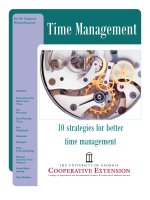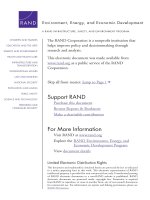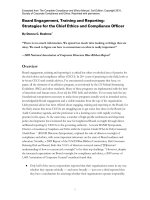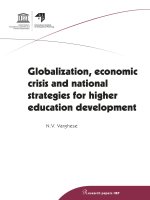emory university digital library publications strategies for sustaining digital libraries apr 2008
Bạn đang xem bản rút gọn của tài liệu. Xem và tải ngay bản đầy đủ của tài liệu tại đây (1.82 MB, 123 trang )
Strategies for
Sustaining
Digital Libraries
Copyright © 2008
This collection is covered by the following Creative Commons License:
Attribution-NonCommercial-NoDerivs 3.0 License
You are free to copy, distribute, and display this work under the following
conditions:
Attribution. You must attribute the work in the manner specified by
the author or licensor (but not in any way that suggests that they
endorse you or your use of the work). Specifically, you must state that
the work was originally published in Strategies for Sustaining Digital
Libraries (2008), Katherine Skinner and Martin Halbert, Eds. and you
must attribute the author(s).
Noncommercial. You may not use this work for commercial purposes.
No Derivative Works. You may not alter, transform, or build upon
this work.
For any reuse or distribution, you must make clear to others the license terms of this
work.
Any of these conditions can be waived if you get permission from the copyright
holder.
Nothing in this license impairs or restricts the author’s moral rights.
The above is a summary of the full license, which is available at the following URL:
Publication and Cataloging Information:
ISBN: 0-9772994-1-4
Editors: Katherine Skinner, Martin Halbert
Copy Editors: Mary Battle
Publisher: Emory University
Digital Library Publications
Atlanta, GA 30322
TABLE OF CONTENTS
List of Tables and Figures iv
Acknowledgements v
Sustaining Digital Libraries: An Introduction (Martin Halbert and Katherine
Skinner, Emory University) 3
Once in a Hundred Generations (Paul Arthur Berkman, University of California,
Santa Barbara) 11
Digital Sustainability: Weaving a Tapestry of Interdependency to Advance
Digital Library Programs (Tyler O. Walters, Georgia Institute of Technology) 22
What Is This New Devilry? Digital Libraries and the Fate of Faculty Scholarship
and Publishing (Bradley Daigle, University of Virginia) 41
Sustainability, Publishing, and Digital Libraries (Michael Furlough, Penn State
University Libraries) 59
Principles and Activities of Digital Curation for Developing Successful and
Sustainable Repositories (Leslie Johnston, University of Virginia) 84
When the Music’s Over (Mary Marlino, Tamara Sumner, Karon Kelly, and
Michael Wright, University Corporation for Atmospheric Research, University
of Colorado at Boulder) 97
About the Editors and Contributors 112
LIST OF TABLES AND FIGURES
Tables
1.1 Sustainability Elements of Digital Information Organizations 16
1.2 Matrix of “Sustainability Vignettes” 18
Figures
1.1 Human Communication Eras 12
1.2 Borromean Rings of Meaning 14
1.3 NSDL Funding 17
2.1 Digital Sustainability Model 28
2.2 Digital Sustainability Model as Applied to MetaArchive 37
3.1 Model of a Digital Library Environment 53
6.1 Digital Library for Earth System Education (DLESE) site 99
ACKNOWLEDGEMENTS
This book was inspired by the Andrew W. Mellon and Robert W.
Woodruff Library sponsored symposium Sustaining Digital
Libraries held at Emory University in the summer of 2006. We
wish to begin by thanking all of the planners, implementers,
presenters, and attendees who helped to make the Sustaining Digital
Libraries Symposium a success.
Our appreciation also goes to the institutions and departments that
provided various kinds of support to enable this symposium,
including the Andrew W. Mellon Foundation, which provided
financial support for the event, and Emory University’s Robert W.
Woodruff Library, which provided the overall framework of
support and the facilities for the conference. We are also grateful to
Rick Luce, Emory University Vice Provost and Director of
Libraries, who both supported and contributed to this event.
The conversations that began at the symposium have carried
forward, in many cases becoming part of this collection of essays.
We would like to thank all of the contributors to this volume, first
for their work in creating and supporting various digital libraries
across the humanities, social sciences, and sciences; and second for
their contributions to the intellectual substance of this book.
Finally, we would like to extend a special thanks to those staff
members of the Digital Programs and Systems division who worked
on both the symposium and the manuscript, including Erika Farr,
Robin Conner, Sarah Toton, and Mary Battle. As we’ve said before,
it often takes a community to write a book, and our community has
been one of support, encouragement, and often great ideas –
something we do not take for granted for even a moment!
Katherine Skinner, Martin Halbert
Atlanta, Georgia
February 2008
Strategies for
Sustaining
Digital Libraries
Edited by Katherine Skinner and Martin Halbert
Emory University
Digital Library Publications
Atlanta, Georgia
K. Skinner and M. Halbert: Introduction
3
Sustaining Digital Libraries: An Introduction
Katherine Skinner (Emory University)
Martin Halbert (Emory University)
Abstract: Outlines the themes and contributions of Strategies
for Sustaining Digital Libraries and offers summary conclusions
about the core topics discussed.
We are at the inception of a new field – that of digital librarianship.
Given that this is an emerging field and that so much is changing
within our underlying infrastructure, how can leaders begin talking
about, planning for, and implementing strategies for sustaining
digital libraries as they become essential sources of knowledge?
It is these questions that have led us to produce Strategies for
Sustaining Digital Libraries. This collection of essays is a report
of early findings from pioneers who have worked to establish
digital libraries, not merely as experimental projects, but as
ongoing services and collections intended to be sustained over time
in ways consistent with the long-held practices of print-based
libraries. Particularly during this period of extreme technological
transition, it is imperative that programs across the nation – and
indeed the world – actively share their innovations, experiences,
and techniques in order to begin cultivating new isomorphic, or
commonly held, practices. The collective sentiment of the field is
that we must begin to transition from a punctuated, project-based
mode of advancing innovative information services to an ongoing
programmatic mode of sustaining digital libraries for the long haul.
This collection of essays began with discussions at a symposium
entitled Sustaining Digital Libraries held at Emory University on
October 6, 2006. Conversations at this symposium highlighted the
need for a book to capture findings, observations, insights, and
advice on this topic, leading the organizers of the event to
champion the creation of this collection. This volume resulted in
part from the dialogue that ensued between experienced leaders of
digital libraries as they explored the most promising models for
sustaining such efforts in the long term.
In the first portion of this introductory essay we will review the
scope of the problem, outline the contributions found in this
monograph, and then offer summary conclusions on the topic.
Strategies for Sustaining Digital Libraries
4
DIGITAL LIBRARIES AND THE EXPANDING UNIVERSE
OF RESEARCH INFORMATION
We take a very broad definitional view of this topic, contending
that all of the myriad networked information resources now used
by scholars (researchers, teachers, and graduate students) should
fundamentally be understood as digital libraries. Such resources
must be sustained over generations in order to support the long-
term needs of scholars for research and citation. But the pace and
scale of the production of new digital resources makes this a
challenging prospect.
A bit of framing context is useful at this point. According to the
“Expanding Digital Universe: A Forecast of Worldwide
Information Growth Through 2010” study by the IDC and EMC
(2007), the world created upwards of 161 exabytes (161 billion
gigabytes) of information in 2006. In isolation, that number is
virtually incomprehensible and means little to most of us. Context
makes the problem space that we are entering more compelling.
The 2006 “digital universe” is estimated to be more than three
million times the information contained in all the books produced
in the history of the world. By 2010, the study forecasts that this
“digital universe” will increase in production by more than six fold
to a staggering 988 exabytes per year.
In other words, the vast majority of our intellectual information is
now being produced, not in print, but in digital formats. Further
complicating matters, we are producing more than we ever have
produced before. How will we ever sift through, access, transport,
secure, and preserve the important bits of our cultural record?
Enter digital libraries.
Wikipedia and various other sources define “digital library” as a
“library in which collections are stored in digital formats (as
opposed to print, microform, or other media) and accessible by
computers.”
1
Delving into this definition, we note that the library is
an organized body that holds collections – digital objects that have
been grouped into categories, presumably for access purposes.
So the cultural record now depends upon digital library collections
that increasingly bring structure to the digital deluge, and that
allow us to make this content useful to its worldwide audiences.
These digital libraries, unlike their physical counterparts, are a
relatively new phenomenon. Physical libraries with organizational
schemes have arguably existed since at least 300 BCE when
K. Skinner and M. Halbert: Introduction
5
Aristotle helped to create the Great Library of Alexandria. Physical
libraries have long-established methods of collecting, organizing,
and preserving information. Likewise, they have a long history of
continued existence.
Digital libraries, on the other hand, are still in their infancy. The
field of digital libraries is still emerging and does not yet have
firmly established practices in place. The good news is that, as
with most field formations, there is much experimentation,
research, and production activity happening throughout the world
as the field begins to define its parameters. The more troubling
news is that much of this experimentation will, in all likelihood,
ultimately fail. This situation demands that we both record and
share our early strides as digital libraries and that we begin to
answer a series of questions regarding the sustainability of the
digital structures that our culture is creating.
SUSTAINABILITY
How can we hope to sustain these digital resources that we are
creating apace? How will we transport, store, secure, and replicate
all of this information? And when those resources are part of a
digital library – broadly defined – how can we sustain the range of
library apparati that undergird these resources?
Merely broaching this topic raises several important questions:
How do we build sustainability into these new operations,
not only in terms of funding streams but the entire
complex of stabilizing processes and institutional forms
that lend sustainability to resources? What is needed,
structurally, to sustain digital libraries once they are
created?
If we don’t have effective structures to sustain digital
libraries yet (and this seems likely), how do we create
them? Institutionalization takes time to permeate society
in terms of accepted practice. Will we have the requisite
time, or will we see an intervening digital dark age when
the majority of the knowledge created by society is lost?
Given the proliferating pace of information cited above,
how can we know (or guess?) what to sustain? The only
certainty we can really claim to know is that we will not
be able to preserve everything, but must apply some
degree of prioritization to the task at hand.
Strategies for Sustaining Digital Libraries
6
Theorists ranging from Huseyin Leblebici and Timothy
Dowd to Clayton Christensen have demonstrated that
successful innovations most often happen on the
periphery, not at the center, of a market.
2
How can we
anticipate which of the many flowers now blooming may
be the crucial ones to devote scarce resources to
sustaining (or at least preserving)? And how patient must
we remain in order to allow this drama to unfold at its
own pace?
The contributors to this volume have some tentative advice to offer
by way of inter-institutional collaboration, or at least coordination.
In some cases they have put forward new cooperative
organizational models to share the burden of supporting new
operations. There are many opportunities for aligning institutional
practices to take advantages of scale and unified workflows.
For every 50 experiments, we may have to realistically expect 49
to perish. We need to watch for the innovations on the fringes that
demonstrate unexpected vitality, and accept the fact that
unsuccessful attempts will pass away.
THE ESSAYS
Our contributors explore the topic of sustaining digital libraries
from many different perspectives:
Paul Berkman distinguishes between digital and other mediums
that preceded it. He highlights unique aspects of the medium and
the elements that are necessary to sustain a digital object. Berkman
looks at both the tasks of sustaining digital objects and sustaining
organizations that are responsible stewards of those objects. He
engages with the necessary economic and political strategies, and
concludes that digital information sustainability is key to the
knowledge management and discovery opportunities that will
empower an enlightened society into the future
Tyler Walters highlights the need for strategic partnerships,
arguing that interdependence is a necessary element in sustaining
scholarly digital resources. He proposes a sustainability model
comprised of four elements: Organization, technology, economic,
and collection-based sustainability. Walters uses the MetaArchive
Cooperative, an inter-institutional preservation organization, and
its host organization, the Educopia Institute, as a case study to
explore how employing this model of interdependence enables
K. Skinner and M. Halbert: Introduction
7
important community-based initiatives to become stable over the
long term
Bradley Daigle explores the impact of the digital medium on
scholarly enterprises and the academic publishing market. He
points to the problems inherent in employing old strategies and
methodologies when engaging in a new medium. Daigle analyzes
the relationship between new scholarship forms and the new
library environments needed to support those new forms. Like
Walters, Daigle proposes that strategic partnerships pose the best
opportunity for libraries to lead the way in this emergent arena and
to continue to serve as support for the apparatus of humanities
scholarship. Finally, Daigle looks at the need for both
infrastructure development and the creation of economic models
for such stewardship of cultural assets in digital form, using the
University of Virginia as a case study.
Michael Furlough examines the recent activities of libraries as
production centers for digital scholarship and the corresponding
shift that must take place in the library’s mission in order to
organizationally sustain these activities. He uses Penn State
University’s press and library to illustrate changing relationships
between these entities due to the emergence of digital scholarship.
Leslie Johnston uses Fedora and the University of Virginia’s
digital collections repository to outline a model for employing
digital curation principles and practices to sustain digital
repositories. She keeps a primary aim in sight: long-term usability
of collections and objects. Johnston pays attention not only to the
curation activities and technical infrastructure, but also to the
social infrastructure – the degree to which a repository and its
sustainability is integrated into the overall institutional mission.
Mary Marlino, Tamara Sumner, Karon Kelly, and Michael
Wright share the strategies that they have developed and
undertaken to provide a sustainability plan for the Digital Library
for Earth System Education (DLESE). Their detailed analysis of
costs and specific planning tasks provides a practical case study of
what is required for sustainability efforts.
CONCLUSIONS
One of the greatest discoveries a man makes, one of his great surprises,
is to find he can do what he was afraid he couldn't do.
- Henry Ford
Strategies for Sustaining Digital Libraries
8
We conclude with a few summary observations of our own as both
editors of this book and leaders within the emerging field of digital
libraries. These observations are offered as words of
encouragement to our many colleagues searching for models to
carry forward their compelling accomplishments in digital
libraries. While the task of sustaining these efforts may frequently
seem like an impossible task, we believe that there are many signs
of hope for our field. When asked, “Can we sustain digital
libraries?” we will answer forthrightly: Yes, we can.
Incremental Sustainability
Our first observation is that sustainability claims only make sense
in some relatively constrained time frame. Nothing is sustainable
forever. Given the shifting sands upon which we currently stand,
we should not ask “Is this digital library sustainable?” but rather
“How long can we be confident of sustaining this digital library at
this moment?” The answer to the first question is always an
ambiguous question mark. The answer to the second question can
be honest, realistic, and backed up with concrete evidence.
A further corollary is that the incremental progress we make
toward sustaining any given digital library will provide us with
growing evidence on which to base subsequent claims and
initiatives. Such progress will also hopefully grant us a growing
base of support from users of digital libraries, whether that support
is commercial or institutional.
This observation should be seen as common sense, applicable to
almost any kind of program, whether a digital library or other kind
of service operation. Businesses look at financial forecasts
constantly, and increasingly traditional print libraries do as well.
The assumption of indefinite sustainability of all traditional library
operations has been demonstrated to be false as more and more
“givens” in traditional libraries go by the wayside. The question is
really (and always should have been) what slate of information
service offerings is desirable enough that stakeholders will sustain
it? This issue brings us to our next observation.
Digital Libraries May Be More Sustainable
Because of the utility of the functions that digital libraries provide,
it may be that they are more sustainable, not less, than traditional
libraries – perhaps much more sustainable. Again taking a broad
perspective on what constitutes a digital library operation, one does
not have to go beyond the colossus of Google to find a service that
K. Skinner and M. Halbert: Introduction
9
is ubiquitously used by academics (along with everyone else). This
company is a powerhouse economically and technically, and
shows every sign of being as sustainable as any digital library
reasonably can be today.
Does this mean that we can already claim victory for digital
libraries and believe that they will have the longevity of print
archives? No. We may legitimately be skeptical of the long term
sustainability of even a behemoth like Google if our timescale is
hundreds of years. But this comes back to the point about
incremental claims of sustainability. We simply do not have
enough accumulated history of digital libraries to make any claims
credibly in a timescale of centuries. We can observe, at least in
theory, that bits can be replicated indefinitely, whereas physical
media degrade with time. On theoretical grounds, digital libraries
may again be more sustainable than traditional libraries.
Critiques of Google and other Internet search engines by research
librarians often miss (or ignore) the point that these businesses
provide a critically useful information service to academic
stakeholders. Indeed, the link analysis algorithms used by Google
could be seen as comparable to (though certainly not the same as)
some of the features of peer review. Sustainability follows value
and utility in our view, and the sooner we internalize this point the
sooner our digital library services will become sustainable. This
observation brings us to our last point.
If You Build Something They Want, They Will Come and
Sustain It
Ultimately there may not be any great mystery about how to
sustain digital libraries. Simply put, create something that
researchers will insist that you continue to provide and that will
inspire them to lend their support toward making it an institutional
funding priority. If the resource or service cannot pass this simple
litmus test, then it probably is not worth sustaining anyway.
Research communities evolve over time and it may or may not be
the case that the perceived permanence of programs like traditional
libraries and archives will be replicated in the digital library
sphere. The possibility that such information services may have
shorter tenure than ossified services based on benign neglect of
print resources does not mean that digital libraries are less valuable
or useful for researchers, it may mean that they may have more
rapid cycles of evolution.
Strategies for Sustaining Digital Libraries
10
Is this a bad thing? We do not think so. Quite the contrary, the
fact that digital library services evolve quickly is a great strength
and source of vitality. The service that adapts quickly to take
advantage of new opportunities may also adapt quickly to new
opportunities for sustainability. The complaint is often heard that
digital library services rely on “soft funding” that “cannot be
counted on.” But if a service cannot attract both opportunistic soft
funding and a level of ongoing support, then it probably does not
represent a fundamentally viable value proposition for researchers.
We are poised at the beginning of a new era in which we may
bring forward the most successful elements of past practices and
combine them with the innovations made possible by changes in
technology, despite the challenges they have posed to the status
quo for librarianship. The coming years will continue to be
exhilarating ones for the pioneers of this new field, who we
celebrate as explorers of new intellectual spaces, and who write the
future in their tentative steps across this unsettled shore.
NOTES
1. Wikipedia, (accessed on
January 24, 2008).
2. See Huseyin Leblebici, Gerald R. Salancik, Anne Copay, and Tom
King. "Institutional Change and the Transformation of
Interorganizational Fields: An Organizational History of the U.S.
Broadcasting Industry." Administrative Science Quarterly 36 (1991):
333-363; Timothy Dowd “Musical Diversity and the Mainstream
Recording Market, 1950 to 1990.” Rassegna Italiana di Sociologia
41 (2000): 223-263 and “Structural Power and the Construction of
Markets: The Case of Rhythm and Blues.” Comparative Social
Research 21 (2003): 147-201; and Clayton Christensen. 1997. The
Innovator's Dilemma: When New Technologies Cause Great Firms to
Fail (Boston, MA: Harvard Business School Press).
REFERENCES CITED
Gantz, John F., David Reinsel, Christopher Chcute, Wolfgang Schlichting,
John McArthur, Stephen Minton, Irita Xheneti, Anna Toncheva, and
Alex Manfrediz. 2007. “The Expanding Digital Universe: A Forecast
of Worldwide Information Growth Through 2010.” IDC and EMC
White Paper, available at />reports/expanding-digital-idc-white-paper.pdf (accessed on
December 14, 2007).
P. A. Berkman: Once in a Hundred Generations
11
ONCE IN A HUNDRED GENERATIONS
Paul Arthur Berkman (University of California, Santa Barbara)
Abstract: Once in a hundred generations – every 2,000 years –
an information technology threshold is reached that changes
human capacity to manage and discover knowledge. Invention
of the digital medium created such a paradigm shift and we are
now faced with the challenge of sustaining the information
products generated with this transformational technology. For
the last several thousand years, libraries and archives have
provided the architectures to manage information based on their
content and context, respectively. With digital technologies,
however, the inherent structure of information (i.e., boundaries
between granules of content) also can be applied to information
management. Lessons learned from the National Science
Digital Library () reveal that technological
as well as organizational and economic strategies are necessary
to sustain digital libraries as “public goods.” Implementation of
a national task force on digital library sustainability is
recommended to elaborate visionary solutions for knowledge
management and discovery in our evolving digital era.
A BRIEF HISTORY OF HUMAN COMMUNICATION
Understanding where we have been is a key to the future. The
opportunity to transform human communication on a global scale
happens once in a hundred generations – every 2,000 years – and
we are living during such a period (Fig. 1.1).
Question 1: What are the distinctions between the digital
medium and all of its hardcopy predecessors?
For thousands of years Neolithic humans shared their life stories
on cave walls (with smoke handprints and colored animal
drawings) or on rocks (with stick figures and symbols) etched for
future generations. Immovable, these images on stone have
weathered the test of time.
Then, nearly 5,500 years ago, clay tablets awakened a new
capacity for humans to share experiences and insights. Rolling
devices – the ancestor of all typesetting – enabled humans to
imprint and reproduce symbols in clay. Clay also had the
advantage of being much easier to transport than stone, but it was
more fragile.
Strategies for Sustaining Digital Libraries
12
FIGURE 1.1: Eras in our civilization based on the media that humans have
used to communicate beyond face-to-face. Each new communication
medium has increased human capacity to: (a) transport information across
time and space; (b) produce more information faster; and (c) integrate
information into relational schema. Conversely, information has become
more ethereal and difficult to preserve from stone to digital. Modified
from Berkman et al. (2006a,b).
A thousand years later, humans invented papyrus to exchange
information with much greater detail and color than ever before.
Papyrus was lighter and more pliable than clay, which made it
easier to distribute. Pieces of papyrus also could be combined to
create complex information sources.
After another two millennia, we saw the advent of paper, which
certainly must rank as one of the most significant inventions in our
civilization. During this period with the Great Library of
Alexandria, clay, papyrus, and paper coexisted as media to share
data and other information beyond face-to-face communication.
On a global scale, paper then took off as the principal medium for
communicating across space and time.
Until the invention (or rather harnessing) of electricity, paper was
unrivaled in the role of sharing knowledge in our world. Then
came digital devices to collect, store, transmit, and display
information. It has only been in the past fifty years that digital
devices have become the communication backbone in our world
information society.
P. A. Berkman: Once in a Hundred Generations
13
Each era of global communication, from stone to digital (Fig. 1.1),
has been accompanied by a threshold increase in human capacity
to transport information. Similarly, each new communication
medium has significantly increased our capacity to produce
information, as indicated by the relative volumes of information
that emerged. Moreover, the ability to integrate information has
increased over time with tablets, folios, books, and now websites.
In contrast, the most resilient medium was stone with petroglyphs
and pictographs that have stood the test of time through rain, snow,
wind, and even fire. Subsequent media have been much more
fragile. In fact, the digital medium has been like a black hole
where most of the information produced has been lost because of
limited preservation strategies and rapid obsolescence of storage
devices.
Over the past 6,000 years, there has been global transformation in
the information management medium every couple millennia.
Paper was most recent with its invention in China around 2,000
years ago, curiously near the start of the Common Era that has
since marked time across our civilization. If the past is any
indication of the future, the digital medium will be with us for
millennia to come. The challenge is to manage our digital
information and to facilitate knowledge discovery for the benefit of
future generations around the world.
KNOWLEDGE MANAGEMENT AND DISCOVERY
Looking backward through time, we recognize that information in
our civilization has been managed largely through libraries and
archives. While similar in their needs to facilitate information
access and preservation, these two architectures possess
fundamental differences. Archives manage information based on
the context of records linked to specific activities and transactions,
like the Bureau of Motor Vehicle records of your car title.
Libraries largely manage information based on the content of the
information resources, as with the subject categories in the Dewey
Decimal System. Beyond content and context there is a third
element of information to establish meaning and that is its
structure (Fig. 1.2).
Question 2: Are there unique aspects of the digital medium
that will enhance knowledge management and discovery?
Strategies for Sustaining Digital Libraries
14
FIGURE 1.2: “Borromean Rings of Meaning” illustrate the three
inseparable elements of information (content, context, and structure) that
provide the basis for understanding and synthesizing knowledge. From
Berkman et al. (2006a,b).
For example, when a message is encrypted (i.e., the structure is
altered) it still has content and context, but no meaning absent the
key to unlock the encryption. Alternatively, if the names or dates
and places are removed from an information resource, it still has
context and structure, but limited meaning without the salient
facts. Similarly, meaning will be compromised by removing the
context that can be used to authenticate an information resource or
establish its provenance.
The paradigm shift created by digital technologies is the
opportunity to dynamically utilize the structure of information as
well as its content and context for the purposes of knowledge
management and discovery. A hardcopy book can be managed
based on its content (as in libraries) or its context (as in archives).
However, it is not possible to automatically break a printed book
into smaller granules of information (chapters, pages, paragraphs,
etc.) that can be managed or discovered independently.
With the digital medium it has become possible to utilize the
content and context as well as structural patterns (such as the white
space formed by an indent or carriage return) to manage sets,
subsets, and supersets of information resources. It is this ability to
P. A. Berkman: Once in a Hundred Generations
15
dynamically manage the granularity of information that
distinguishes the digital medium from all of its hardcopy
predecessors in our civilization (Fig. 1.1).
Content, context, and structure of information create meaning that
can be interpreted across a spectrum of understanding (Liebowitz
1999). The value of information is that it provides the foundation
to synthesize knowledge that enables individuals to determine the
course of their actions. Knowledge, which can be simply defined
in terms of information relationships, is the epitome of learning
(Bloom 1956) and the aspiration of all educated people.
DIGITAL INFORMATION SUSTAINABILITY
Digital libraries and archives, which are emerging around the
world (Arms 2000; Thibodeau 2001; NDIIPP 2002; Greenstein and
Thorin 2002; Hodges et al. 2003; Lesk 2004; Duranti 2005), reflect
the issues of sustainability. The following lessons are from the
National Science, Technology, Engineering and Mathematics
Education Digital Library, or NSDL, () that
originated in 2000 as a “community based endeavor” supported by
the National Science Foundation ().
The NSDL established a “working structure” with a Core-
Integration Team, Policy Committee, five Standing Committees, a
National Visiting Committee and other entities as approved by an
Assembly of the projects (
Supported projects contribute to the NSDL program by producing
collections and services that have value to user, producer, and
sponsor communities. Technical innovations are woven
throughout so that the digital library can be effectively operated
and applied. Generalizing, the NSDL “working structure” reveals
underlying sustainability elements of any digital information
organization (Table 1.1).
Strategies for Sustaining Digital Libraries
16
Organizational strategies to implement the NSDL are further
reflected by the projects that have been funded, effectively in two
phases before and after 2003 (Fig. 1.3). Between 2000 and 2003,
NSDL funded 88 collection, 45 service, 29 Core Integration, and
19 research projects. In 2004, characteristics of the NSDL
conceptually changed with elimination of the track for collection
projects and the emergence of pathways projects “to provide
stewardship for the content and services needed by major
communities of learners” (). From 2004 to
2006, there have been an additional 31 Core Integration, 21
pathways, 22 service, and eight research project awards. Together,
these NSDL awards have been distributed across 35 states (NSDL
2007).
TABLE 1.1: Sustainability Elements of Digital Information Organizations
a
ELEMENT
SCOPE OF ACTIVITIES
Program
Long-term administrative strategies for collaboration among
developers, users, sponsors, and other stakeholders to “anchor”
the digital information organization
Projects
Public-private-university-government strategies to support the
creation, maintenance, funding and evolution of needed
collections and services
Communities
Engagement, networking, and evaluation strategies to meet the
demands of users, developers, and sponsors
Technical
Application strategies to achieve long-term preservation, access,
and knowledge discovery with digital information
a
See the Sustainability Standing Committee homepage
( Adapted from Berkman (2004).
P. A. Berkman: Once in a Hundred Generations
17
FIGURE 1.3: Cumulative funding by the National Science Foundation
for different types of projects (legend) in the National Science,
Technology, Engineering, and Mathematics Education Digital Library
(). Data are from NSDL (2007).
In addition to conceptual changes, the shift in organizational
emphasis before and after 2003 is represented by the relative
support for Core Integration, which is responsible for integrating
the NSDL projects. During the 2000-2003 period, Core
Integration accounted for 16% of the projects and 19% of the
NSDL funding. Afterward, these percentages increased to 34%
and 43%, respectively. These adjustments in the NSDL reflect the
distributed-centralized continuum of architectures that can be
implemented for digital information organizations in general.
Question 3: What is the optimal allocation of resources to
balance the elements (Table 1.1) that are needed to sustain a
digital information organization?
FUNDING PUBLIC GOODS
To better understand the economics of digital libraries, stories from
NSDL projects that were considered to be sustainable were
captured in a series of written vignettes (Table 1.2). These projects
all existed prior to 2000 and provide potential anchors for long-
term development of the NSDL organization, which is why many
of them have received pathways funding.









